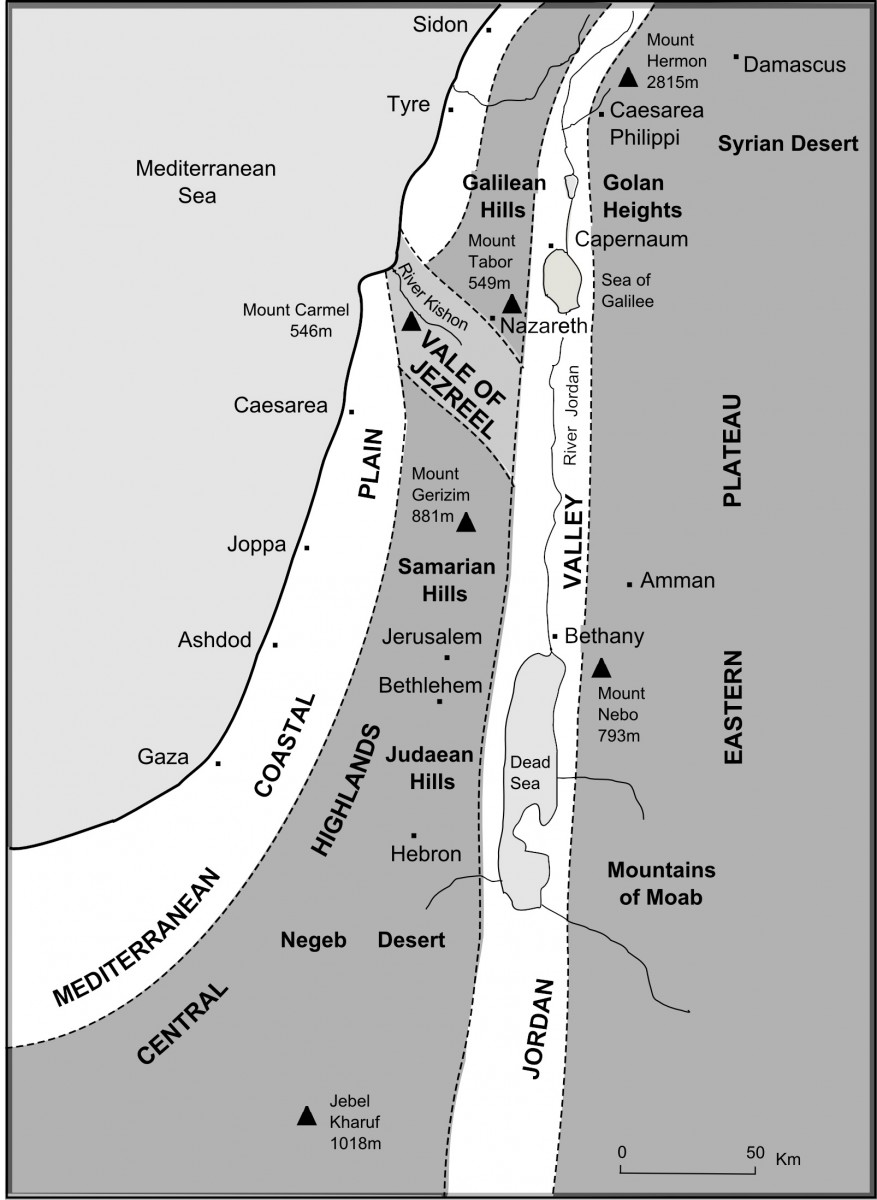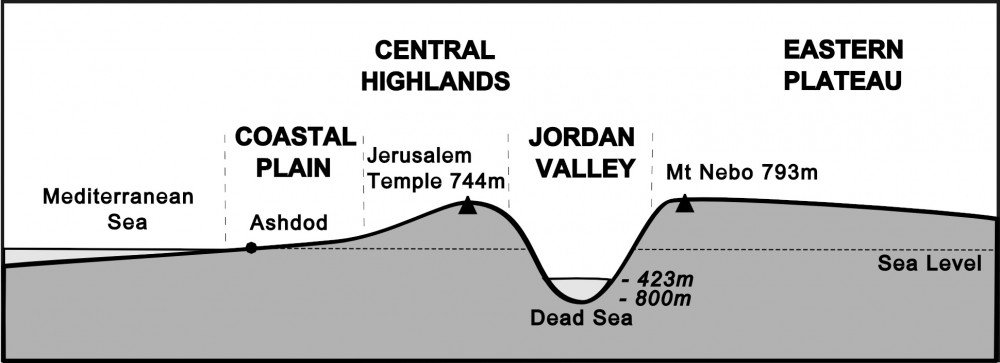The New Testament tells the story of Jesus as a man on the move. He spends much of his ministry travelling from place to place, moving frequently from Galilee in the north, to Jerusalem, 65 miles / 105 km to the south, in Judaea. The key events of the New Testament unfold in the context of these numerous journeys across four very different landscapes of Palestine* (see Map 1 and Fig. 1) (* see the note on Palestine at the foot of this page).
Map 1 Landscapes of Palestine


Fig. 1 Simplified cross-section
Each of these four landscapes features in the New Testament journeys:
The Central Highlands
Jesus of Nazareth is born at Bethlehem in the hill country of Judaea. He is brought up in the hills of Galilee at Nazareth and – as a child – goes up to Jerusalem in the Central Highlands each year for the Passover festival (see Luke 2:4, 39 & 41-43).

The Central Hill Country of Galilee (Luke 2:4)
The Jordan Valley
John the Baptist challenges people to change their lifestyle at Bethany in the Jordan Valley. Jesus is baptised in the River Jordan and moves to Capernaum – a fishing port on the Sea of Galilee – where he recruits his first disciples and establishes the main base for his ministry (see John 1:26-36, Matthew 3:13-17 & Mark 1:14-21).

The Jordan Valley near Deganya (Matthew 3:13)
The Mediterranean Coastal Plain
After the birth of Jesus, Mary and Joseph flee across the Mediterranean coastal plain to Egypt to escape the murderous wrath of Herod the Great. During his ministry, Jesus visits the Mediterranean coastal towns of Tyre and Sidon. Later, Peter has a vision beside the Mediterranean Sea at Joppa, and agrees to meet a centurion at the Roman port of Caesarea (see Matthew 2:13-15, Mark 7:24-31 & Acts 10:1-48).

The Coastal Plain near Joppa (Acts 9:36)
The Eastern Plateau
Jesus travels with his disciples to the source of the River Jordan near Caesarea Philippi where he is transformed before their eyes on the summit of Mount Hermon (see Matthew 17:1-8). Paul climbs the Golan Heights and journeys across the Eastern Plateau towards Damascus, where he sees a blinding light and hears the risen Lord Jesus saying to him, “Why are you persecuting me?”(Acts 9:4).

The Eastern Plateau rising above the eastern shore of the Sea of Galilee (Mark 5:1)
Was this wider region called Palestine, Israel or Judaea in New Testament times?
In the New Testament section of The Bible Journey we use the name Palestine to indicate the wider region in which Jesus was born and carried out his ministry. This area was referred to as Palestine by the Romans in New Testament times.
The name Palestine was first used by the Ancient Greeks to refer to the land of the Philistines (who inhabited the southern Levant from about the 12th century BC and are referred to in the Old Testament e.g. in 1 Samuel 31:1-3 - see Saul is killed by the Philistines at Mt Gilboa - The Bible Journey - which occurred in c.1011BC.)
The Greek historian Herodotus in 'The Histories' used the name Palestine in the 5th century BC to refer to the land bordering the Mediterranean between Phoenicia in the north and Egypt in the south, stretching inland across the Judaean Hills to the Jordan rift valley. Later Greek writers such as Aristotle (384BC - 322BC) and Roman writers including Ovid (43BC - 17AD) and Pliny the Elder (c.23AD - 79AD) used the name Palestine for this area, as did the Jewish philosopher Philo of Alexandria (c.20BC - 50AD) and the Jewish historian Josephus (c.37AD - 100AD).
When the Romans took control of the area where Jesus was born (in 63BC), they called it Judaea, not Israel - see The Rulers of Palestine - The Bible Journey. Consequently. the New Testament tells us that Jesus was born in Bethlehem in Judaea - see Mary & Joseph go to Bethlehem - The Bible Journey - shortly before the death of King Herod, called the 'King of the Jews' by the Romans, or the 'King of Judaea' (signifying 'the land of the Jews').
The Romans renamed this province Syria Palestina in 135AD, but the region had been widely referred to as Palestine for at least 500 years before that.
